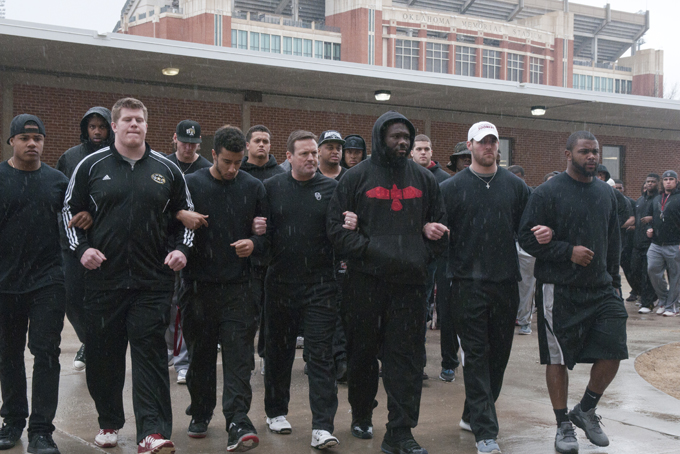
NORMAN, Okla. (AP) – Almost a generation ago, the University of Oklahoma set out to raise its profile, seeking to build a regional school that served mostly students from the Southwest into a leading institution that attracted top scholars.
President David Boren made striking progress, achieving a reputation that now extends well beyond the Sooners football team that once defined the campus. But those improvements seem in peril after members of a fraternity were caught on video making a racist chant that referenced lynching and indicated Black students would never be admitted to OU’s chapter of Sigma Alpha Epsilon.
Boren, a former Oklahoma governor and U.S. senator with 20 years at the helm of the state’s flagship university, acted swiftly. He immediately severed ties with the fraternity and ordered members to vacate their house by midnight. On Tuesday, he expelled the two students who appeared to be leading the chant for creating a hostile educational environment and promised others involved would face disciplinary action.
“I have emphasized that there is zero tolerance for this kind of threatening racist behavior at the University of Oklahoma,” Boren said in a statement.
But some students at OU, particularly African-Americans who make up about 5 percent of the campus population, said racism is alive and well and that a mostly segregated fraternity and sorority system is at least partially to blame for creating an environment where racism can thrive.
On Monday, a top high school football recruit withdrew his commitment to attend the university after seeing the video.
North Mesquite High School football star Jean Delance, a top offensive lineman prospect, told KTVT television and KRLD-AM in Dallas-Fort Worth that he spoke Sunday night with coach Bob Stoops, but wasn’t told about the incident.
“I’m very disappointed in the coaches not letting me know,” Delance told KRLD. “But that was just heart-breaking right there.”
The Oklahoma football team decided to protest rather than practice Monday. At the team’s indoor practice facility, coach Bob Stoops led the way as players, joined by athletic director Joe Castiglione, walked arm-in-arm, wearing black.
“It’s too segregated,” said Markeshia Lyon, a junior from Oklahoma City who is Black. “That’s something that’s passed down, and that’s something that needs to change.”
Lyon recalled trying to attend a fraternity party her freshman year with several friends, all of whom were African-American, and being told they were not welcome.
“It was very hurtful,” she said. “I would never set foot on that street again.”
But fraternity members say chapters at Oklahoma have taken steps to diversify, recruiting more African-American, Asian and Hispanic students.
“We’ve always fostered a community where anyone who is qualified can enter. We don’t look at your race,” said Jordan Bell, an African-American senior from Washington, D.C., who joined a mostly White fraternity. He said more than 10 percent of the roughly 100 members of his Phi Kappa Psi fraternity now are African-American.
Bell said some fraternities and sororities are more diverse than others, and Boren acknowledged at a news conference Monday that more needs to be done to attract minority students to the university and the fraternity-sorority system.
“Some are doing quite well. They’re making progress,” Boren said. “Others are still locked in the past, and they need to realize that it enriches the experience and the friendships that are involved if they become more diverse as organizations.
“I don’t think we can paint the whole Greek system with a broad brush.”
The university has succeeded in breaking down some racial barriers, mainly through its athletics programs, which is why the video reopens old wounds.
Running back Prentice Gautt, for example, became the first Black football player at the school in the late 1950s, long before many universities had integrated collegiate athletics. Yet today, members of the school’s predominantly Black football and basketball programs play before overwhelmingly White crowds.
While the school made strides on the playing field, it seemed to be losing ground elsewhere. The enrollment of Black students declined. Ten years ago, roughly 6 percent of students at the Norman campus were Black, according to university statistics. Last year, the figure hovered just above 5 percent.
The video also revived painful memories of the state’s history of racial violence.
In 1921, a race riot in Tulsa left some 300 blacks dead and an entire section of town in economic turmoil – scars that remain today in the state’s second-largest city.
Only two years ago, the Tulsa City Council voted to rename the city’s glitzy arts district, which had been named after Wyatt Tate Brady, the son of a Confederate veteran and Ku Klux Klan member. But the change was vehemently opposed by some locals.
An entire swath of southeastern Oklahoma is still called Little Dixie today.
JeffriAnne Wilder, associate professor of sociology at the University of North Florida in Jacksonville – where a school board decided in 2013 to rename a high school named after an honorary Ku Klux Klan leader – said the incident at OU is a quick reminder of how far the state, and the U.S., has to go in dealing with racial issues.
“It’s saddening and unfortunate that just a few days ago, we were commemorating Selma,” Wilder said, referring to the 1965 civil rights march in Alabama from Selma to Montgomery. “We have to pause and on one hand, we can look back and see how far we’ve gone and on the other hand, how far we have to go.”
“The millennial generation,” he added, “is supposed to be both colorblind and post-racial, but that’s not true.”
___
Juozapavicius reported from Tulsa.
___
Follow Sean Murphy at www.twitter.com/apseanmurphy and Justin Juozapavicius at www.twitter.com/juozapa .